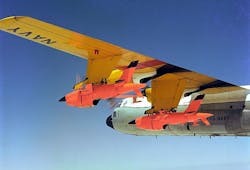Gremlin drone swarms to overwhelm enemy defenses with reconnaissance and electronic warfare UAVs
ARLINGTON, Va., 17 Sept. 2015. U.S. military researchers want to develop the ability to use C-130 aircraft to launch drone swarms of networked and cooperating unmanned aircraft for electronic attack and reconnaissance missions from standoff ranges, and then use other C-130 utility aircraft to recover as many of these drones as possible.
Officials of the U.S. Defense Advanced Research Projects Agency (DARPA) in Arlington, Va., released a broad agency announcement Wednesday (DARPA-BAA-15-59) for the Gremlins program, which relies on relatively inexpensive unmanned aerial vehicles (UAVs) in volley quantities to saturate enemy defenses.
The Gremlins approach would launch swarms of UAVs with a variety of surveillance and electronic warfare (EW) payloads from aircraft beyond enemy air defenses, and then recover surviving UAVs when they have completed their missions.
The idea is to design UAVs that are inexpensive enough so that occasional losses would not compromise the overall mission. Furthermore, the drones would communicate and cooperate with one another, so surviving drones could assume the roles of those unmanned aircraft lost during the mission.
DARPA researchers want to develop affordable UAVs that could be reused as many as 20 times for dangerous missions in contested air space like pre-attack reconnaissance and surveillance, as well as electronic attack to destroy or disable enemy communications, missile defenses, and battlefield networks.
Related: UAV swarm technology emerges to perform varied applications
These drones would be fitted with diverse payloads in volley quantities, and would have the attributes of small vehicle size, reusability, and limited vehicle design life, DARPA officials say.
Key enabling technologies include aerial launch and aerial recovery techniques, equipment, and aircraft integration concepts; low-cost, attritable airframe designs; design for limited life; automated waveoff strategy; precision digital flight control and navigation; aerial refueling techniques; efficient small turbine engines; automated fuel tank inerting and engine shutoff; small distributed payload integration; and precision station keeping.
DARPA will pursue the Gremlins program in three phases: system and technology design; preliminary design; and prototype flight demonstration. This solicitation concerns only the first phase, will involve several different contractors, and spend about $15.8 million.
Ultimately DARPA wants a Gremlins flight demonstration by early 2020 to show the feasibility and potential of air-launched, recoverable unmanned aircraft. Only phase-one contractors will be eligible to participate in the program's second and third phases.
Related: Hunter-Killer UAVs to swarm battlefields
The program seeks to make a fundamental shift in the notion of aerial attack. Instead of using conventional, monolithic systems to conduct missions in denied environments, DARPA wants to use several platforms with coordinated and distributed warfighting functions to saturate adversary defenses.
The idea is to use conventional aircraft hosts to transport and launch a volley of gremlins from stand-off ranges. Researchers want to scale-up the number of UAVs such that a loss of any individual drone is reduced as a result of the collaboration between vehicles.
Not only does the program have the potential to enable enhanced mission effectiveness in contested environments, but it also explores an approach to reduce the cost of operations dramatically.
DARPA officials envision the primary focus of the Gremlins program to be on the technical challenges of aerial launch and recovery of volley quantities of air drones.
Related: Boeing and John Hopkins University demonstrate control of UAV swarm from laptop and radio
Ideally, the host C-130-based aircraft equipment would be roll-on, interfacing with standard air vehicle interfaces to reduce integration and airworthiness effort, turn-around time, and costs.
DARPA officials will brief industry on Gremlin program details from 12:45 to 5 p.m. on 24 and 25 Sept. 2015 at the DARPA Conference Center, 675 N. Randolph St. in Arlington, Va. Register to attend no later than Friday, 18 Sept. 2015, online at https://www.schafertmd.com/darpa/tto/gremlins/proposersday/.
Companies interested in participating in the DARPA Gremlins program should submit abstracts no later than 28 Sept. 2015, and full proposals no later than 17 Nov. 2015.
Email questions or concerns to DARPA at [email protected]. More information is online at https://www.fbo.gov/spg/ODA/DARPA/CMO/DARPA-BAA-15-59/listing.html.

